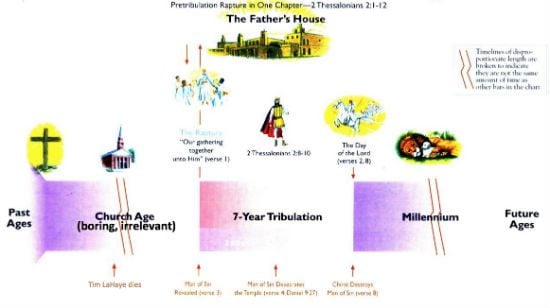Left Behind, pg. 456
We left off here:
Carpathia raised the .38, cocked it, and stuck the barrel into Stonagal’s right ear. The older man at first jerked away, but Carpathia said, “Move again and you are dead.”
We’ve discussed how disappointing it is that the Antichrist’s first on-screen kill should involve something as mundane as a handgun. I was hoping for something creepier, something a bit more supernatural or cinematic.
A second disappointment here involves the death of my dim and implausible hope that Nicolae Carpathia might turn out to be an interesting tragic villain. Up until those two sentences above that was still, at least theoretically, a possibility. After all, Nicolae came preaching a message of “love, peace, understanding and brotherhood.” If he had genuinely believed in such ideals, but had tried to impose and enforce them by imperial fiat, we’d have been looking at the stuff of tragedy. This scene confirms that’s not going to happen here. Nicolae Carpathia, it turns out, is just going to be one of those mustache-twirling villains inexplicably dedicated to villainy for villainy’s sake.
What’s harder to figure out is whether this villainy makes Nicolae a hypocrite in the authors’ eyes when he’s preaching his message of love, peace, understanding and brotherhood. Nicolae Carpathia, remember, is also a “thoroughgoing pacifist,” a man described as “a peacemaker … leading a movement toward disarmament.”
Now we find this alleged pacifist wielding a gun and threatening lethal violence. In any other book, I’d know what to make of that. “Aha,” I would think, “so he’s not really a pacifist after all.” Seeing the character’s actions contradict his words, I would conclude that his words must have been false. Actions speak louder, etc.
Here in Left Behind, however, things are a bit more complicated. In these pages, words are almost always more important than deeds. And in these pages I’m not certain that being a “pacifist” precludes killing people with a handgun.
Let’s deal with the latter point first. We’ve noted earlier (see “Cursed are the Peacemakers“) how Nicolae’s pacifism and his dedication to peacemaking marked him as morally suspect from the authors’ point of view. This idea is simply a given for Tim LaHaye and his premillennial dispensationalist colleagues, and they treat it as such, presenting this audacious bit of up-is-downism with a disarming matter-of-factness. The Antichrist is diabolically evil, they say, and so of course he’s a man of peace, what else might one expect?
As Alice discovered in Wonderland, this kind of confident, reassured madness can be difficult to engage. We don’t have any way of knowing what the rules are when we talk to such people. The accustomed meaning of words and logic don’t seem to apply. It doesn’t help when LaHaye et. al. explain that they’re just repeating what they read in the Bible because no amount of Bible-reading will take you through the looking glass to this alien world where goodness is proof of evil.
So let me try to retrace their steps as they travel from Point A to Point Crazy.
It starts with this idea of the Antichrist. We looked earlier (see “Speakerphone“) at the way PMDs put together their Antichrist Check Lists by collecting every generic warning against evil in the Bible and reinterpreting these as a unified warning against a single, future personification of evil: The Antichrist. This vast collection of biblical passages warning against evil includes several passages warning readers not to be deceived by false promises of peace.
So far, so good. According to the convoluted allegorical scheme of the PMDs “literal” reading, then, it makes sense for them to apply those warnings about false promises of peace to this future Antichrist. But that’s as far as the internal logic of this scheme takes you. If PMD were consistent with itself, it would teach that the Antichrist will be a sham-peacemaker, someone who pretends to be concerned with peacemaking, but really isn’t.
That’s more or less the picture one gets from the early 20th-century prophecy gurus — people like C.I. Scofield, the man who first popularized Darby’s psychedelic invention through his “Reference Bible.” To Scofield and his contemporaries, the Antichrist would be an evil man who, at first, pretended to be a good man. Part of that false facade of goodness would be the Antichrist’s claim to be a proponent of peace. Their assumption, in other words, was that genuinely advocating peace was a Good Thing. They believed that by pretending to be good, pretending to be a man of peace, the Antichrist would lull the world into a false sense of security and then, abruptly, reveal his true self: the rider on the white horse, armed and crowned, riding out “as a conqueror bent on conquest.” They saw “man of peace” and “conqueror bent on conquest” as two different, incompatible things.
Scofield’s contemporary heirs, however, seem to think that “peace” and “conquest” are just two words for the same thing.
In the latter half of the 20th century, the most popular “Bible prophecy scholars” — from Hal Lindsay to Tim LaHaye — moved away from the idea that the Antichrist would be making false promises of peace and began to suggest that this ultimate personification of evil would be an actual peacemaker. This happened, in part, due to their reinterpretation of PMD through the lens of America’s so-called “culture wars.” LaHaye came to PMD carrying with him all the baggage and presuppositions of his John Birch Society, McCarthyist Cold-War paranoia. Lindsay came to it in full-blown panic over Vietnam and the ’60s. Neither of them was capable of imagining such a thing as a false peacemaker because they did not believe there was such a thing as a genuine peacemaker.
To LaHaye and Lindsay, all peacemakers were, by definition, false. All proponents of peace, from their point of view, were duplicitous fools — not peacemakers, but peace-niks. At best they might merely be cowardly, dovish dupes, but at worst they are subversive fifth-column agents of the enemy.* The PMD teaching that the Antichrist himself will one day rise from the ranks of such peaceniks simply confirms what they already believed to be true: that anyone advocating peace should be presumed guilty.
So the biblical warnings not to be deceived by false promises of peace have evolved into the belief that any promise of peace — or any effort to achieve peace, or any policy that includes peace as its ultimate stated goal — is itself false and, in fact, Satanic.
This belief has real-world repercussions. Many of those biblical warnings specifically mention deceivers making false promise of peace with Israel. Thus whenever LaHaye & Co. hear anyone speak of a plan for peace in the Middle East, they assume that this person is helping to pave the way for the Antichrist’s imminent reign — or that he may even be the Antichrist himself. All such plans — from Oslo to the current “Roadmap” — are therefore denounced as evil and vigorously opposed in the name of “supporting Israel.” Supporting Israel comes to mean ensuring that it never achieves peace with its neighbors. Up-is-downism as foreign policy.
So let’s get back to the scene we’re reading now. Since LaHaye views peace only as a mask for conquest, it may be that we’re not meant to see anything contradictory at all in what we’re witnessing. Nicolae Carpathia is a pacifist. Nicolae Carpathia sticks a loaded gun in Jonathan Stonagal’s ear and pulls the trigger. For LaHaye, that action doesn’t reveal Nicolae’s true nature as a lethally violent non-pacifist, but rather it reveals what he believes is the lethally violent, tyrannical true nature of pacifism itself. (Poor LaHaye must be terrified in Amish country.)
Really, though, it’s hard to know what to make of this apparent contradiction between Nicolae’s claims and his actions because the universe of Left Behind doesn’t recognize such contradictions as a possibility. In this book, words trump actions. The authors have stated that Nicolae is a pacifist and, according to the rules of this book, that makes him a pacifist even when he’s firing a gun into someone’s ear.
Bad Writing reinforces this. LB offers innumerable instances in which what we are told about a character seems to contradict the behavior we witness from that same character. We’re told, for instance, that Buck Williams is a “star reporter,” much admired by his readers and his peers for his unrivaled journalistic skills. But what we actually see of Buck is a lazy, incurious, ethically compromised hack who never files a story. Likewise we’re told, repeatedly, that Rayford Steele is a good person, while the evidence we have been shown all seems to contradict this.**
But the Bad Writing here is, I think, part of the effect and not the cause of this inverted hierarchy of words and deeds. The problem isn’t a failure of execution — it’s not that Jenkins is trying, but failing, to have the characters demonstrate the things he claims about them. The problem, rather, is a seeming disregard for any such correspondence between words and actions. He doesn’t have to care whether or not they correspond, because it’s only the words that matter. In a sense, then, Jenkins’ notion of characterization matches his and LaHaye’s notion of salvation, repentance and conversion — they’re all just a matter of saying the magic words.
And but so anyway, here we are:
Carpathia raised the .38, cocked it, and stuck the barrel into Stonagal’s right ear. The older man at first jerked away, but Carpathia said, “Move again and you are dead.”
Does this mean that Nicolae Carpathia is no longer a pacifist? I have no idea.
– – – – – – – – – – – –
* We looked at this anti-peacemaker attitude in that earlier LPU&B post. There I wrote of people like LaHaye that: “They’ve gotten so caught up in guarding against wolves in sheep’s clothing that anything in sheep’s clothing is viewed as the enemy. So all sheep must be shot on sight.” That probably understates the problem. LaHaye doesn’t believe there’s really any such thing as sheep, just a wooly fifth column of wolves.
** We’re also told repeatedly that Rayford Steele really, truly loved his wife Irene, even though neither readers nor Irene ever saw much in his behavior that would demonstrate this to be true. I’m willing to give L&J a partial pass on that one since this particular mistake is hardly unique to LB. The idea that love is something one says or feels (passionately and sincerely), rather than something one does, is a widespread confusion shared by many people who have never even heard of this book.












